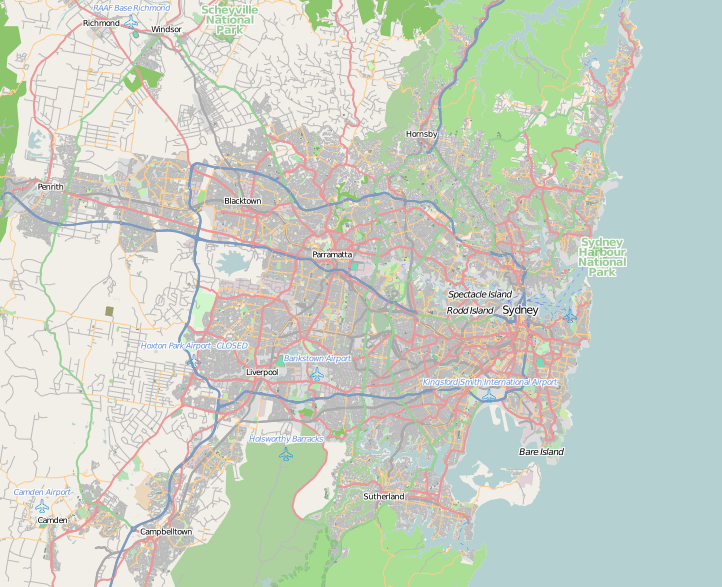Marika, Hunters Hill
Marika is a heritage-listed residence located at 46 Ryde Road, Hunters Hill in the Municipality of Hunter's Hill local government area of New South Wales, Australia. It was built during 1904. It is also known as Rye. It was added to the New South Wales State Heritage Register on 2 April 1999.[1]
| Marika, Hunters Hill | |
|---|---|
.jpg) | |
| Location | 46 Ryde Road, Hunters Hill, Municipality of Hunter's Hill, New South Wales, Australia |
| Coordinates | 33°49′38″S 151°08′15″E |
| Built | 1904 |
| Architectural style(s) | Federation |
| Official name: Marika; Rye | |
| Type | State heritage (built) |
| Designated | 2 April 1999 |
| Reference no. | 300 |
| Type | House |
| Category | Residential buildings (private) |
 Location of Marika, Hunters Hill in Sydney | |
History
Indigenous history
At the time of European contact the Kelly's bush area was inhabited by the Wal Umedegal Clan who spoke the Guringai language. They lived primarily on fish and shellfish, supplementing their diet when necessary with vegetables, marsupials, birds and grubs. They were also frequently observed firing the scrub both to facilitate access to the foreshore and to flush out game. Very little is known of their social structure and religious beliefs.[1][2]
Colonial history of Hunters Hill
Captain John Hunter (1737-1821) of the Sirius, charted Sydney Harbour in 1788. On 28 January 1788 he wrote in his journal: "A few days after my arrival with the transports in Port Jackson, I set off with a six-oared boat and a small boat, intending to make as good a survey of the harbour as circumstances would admit: I took to my assistance Mr Bradley, the first lieutenant, Mr Keltie, the master, and a young gentleman of the quarter-deck (midshipman Henry Waterhouse)." Hunter's meticulous chart shows 30 depth soundings around the peninsula bounded by the Parramatta and Lane Cove rivers. Hunter was Governor of the Colony from 1795-1800. He is commemorated in the name of Hunters Hill.[1][3]
In 1855 a speculative housing venture of erecting four prefabricated Swiss Cottages at Hunters Hill was underway. In this period Hunters Hill was an established French enclave, with the residence of the French consul located there at "Passy", and much of its early development was constructed by men of French descent. The prefabricated houses were advertised as "four splendid family residences, standing in their own grounds, of about zero point four zero hectares (one acre) each", with "wood and water in abundance".[1][4]
Beverley Sherry in her study of Hunter Hill notes that this was the first planned group of houses to be built in the municipality, marking the beginning of the garden suburb character of Australia's oldest Garden Suburb The subdivision and garden suburb development occurred in the mid to late nineteenth century, predating the formation of the Garden Suburb movement. The historic development at Hunters Hill was consistently speculative, although some of the subdivisions were undertaken to provide residences for family members.[1][5]
Marika
The land on which Marika is built was part of a 30 acres grant made in 1835 to Frederick Augustus Hayne.[1]
He sold to Dr. Leopold Augustus Carter, a dentist oin 1902. The house was listed was Ryde in the Sand's Directory in 1904.[1]
In 1938 Dr. Carter sold to the Caveneagh family who sold it around 1981.[1]
From 1981 to 1983 Marika was restored.
A Permanent Conservation Order was placed over Marika on 2 December 1983. It was transferred to the State Heritage Register on 2 April 1999.[1]
Description
Site and grounds
Marika is prominently located on a rise and bend corner site of Ryde Road and covers two large blocks of land with remnants of original formal garden pattern layout, including mature trees, flower beds and paths.[1]
House
.jpg)
The house is an intact example of the Federation style of architecture. Built of timber and galvanised iron roof. It displays fine quality timber craftesmanship, joinery and detail. Coloured glass panels to the windows and oddrs, timber detailing on the decorative gables, verandah window hoods at the sides and back of house and bay windows to the northern side. Chimney detailing.[1]
Condition
As at 4 January 2013, its physical condition is excellent.[1]
Modifications and dates
- 1981-1983 Restoration and renovation
- 1993 - Tennis court and garage constructed[1]
Heritage listing
.jpg)
Constructed in 1904, Marika is an outstanding example of the Federation style of architecture. As at 22 January 2013, it continues to display fine quality timber craftesmanship and joinery. Reputedly built by a tradesman joiner it exhibits quality construction and detail rarely equalled. It is prominently located on a rise and bend corner site of Ryde Road and covers two large blocks of land with remnants of original garden layout, including mature trees, flower beds and paths.[1][6]
Marika was listed on the New South Wales State Heritage Register on 2 April 1999.[1]
References
| Wikimedia Commons has media related to Marika, Hunters Hill. |
- "Marika". New South Wales State Heritage Register. Office of Environment and Heritage. H00300. Retrieved 1 June 2018.
- Pitt, Helen (2011). 'The Gang'. The (sydney) Magazine. The Sydney Morning Herald.
- Sherry/Hunters Hill Historical Society, 2011, 15
- Sherry 1989, 48.
- Mattingley, C. (2007). Nora Heysen - stands tall as artist & benefactor, in 'National Library of Australia News'.
- Heritage Branch files
Bibliography
- Mattingley, C. (2007). Nora Heysen - stands tall as artist & benefactor, in 'National Library of Australia News'.
- Pitt, Helen (2011). 'The Gang'. The (sydney) Magazine. The Sydney Morning Herald.
- Sherry, Beverley (2011). 'John Hunter', entry (Valentia Street Wharf footpath plaque).
Attribution
![]()